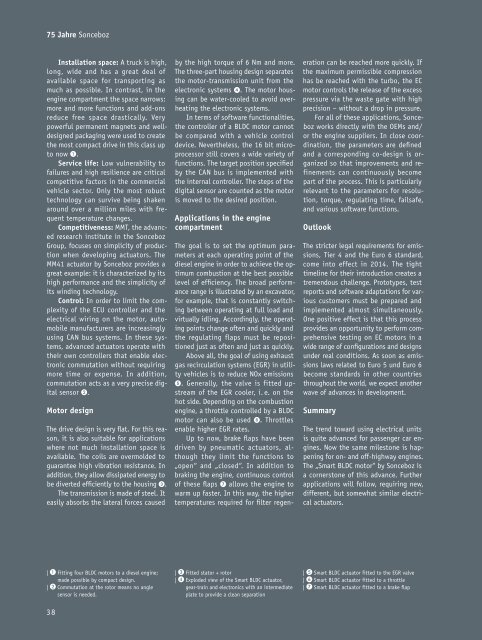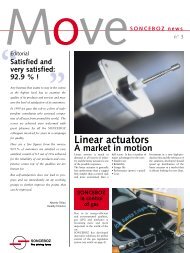75 Jahre Sonceboz 75 years Sonceboz
75 Jahre Sonceboz 75 years Sonceboz
75 Jahre Sonceboz 75 years Sonceboz
Sie wollen auch ein ePaper? Erhöhen Sie die Reichweite Ihrer Titel.
YUMPU macht aus Druck-PDFs automatisch weboptimierte ePaper, die Google liebt.
<strong>75</strong> <strong>Jahre</strong> <strong>Sonceboz</strong><br />
Installation space: A truck is high,<br />
long, wide and has a great deal of<br />
available space for transporting as<br />
much as possible. In contrast, in the<br />
engine compartment the space narrows:<br />
more and more functions and add-ons<br />
reduce free space drastically. Very<br />
powerful permanent magnets and welldesigned<br />
packaging were used to create<br />
the most compact drive in this class up<br />
to now ❶.<br />
Service life: Low vulnerability to<br />
failures and high resilience are critical<br />
competitive factors in the commercial<br />
vehicle sector. Only the most robust<br />
technology can survive being shaken<br />
around over a million miles with frequent<br />
temperature changes.<br />
Competitiveness: MMT, the advanced<br />
research institute in the <strong>Sonceboz</strong><br />
Group, focuses on simplicity of production<br />
when developing actuators. The<br />
MM41 actuator by <strong>Sonceboz</strong> provides a<br />
great example: it is characterized by its<br />
high performance and the simplicity of<br />
its winding technology.<br />
Control: In order to limit the complexity<br />
of the ECU controller and the<br />
electrical wiring on the motor, automobile<br />
manufacturers are increasingly<br />
using CAN bus systems. In these systems,<br />
advanced actuators operate with<br />
their own controllers that enable electronic<br />
commutation without requiring<br />
more time or expense. In addition,<br />
commutation acts as a very precise digital<br />
sensor ❷.<br />
Motor design<br />
The drive design is very flat. For this reason,<br />
it is also suitable for applications<br />
where not much installation space is<br />
available. The coils are overmolded to<br />
guarantee high vibration resistance. In<br />
addition, they allow dissipated energy to<br />
be diverted efficiently to the housing ➌.<br />
The transmission is made of steel. It<br />
easily absorbs the lateral forces caused<br />
by the high torque of 6 Nm and more.<br />
The three-part housing design separates<br />
the motor-transmission unit from the<br />
electronic systems ➍. The motor housing<br />
can be water-cooled to avoid overheating<br />
the electronic systems.<br />
In terms of software functionalities,<br />
the controller of a BLDC motor cannot<br />
be compared with a vehicle control<br />
device. Nevertheless, the 16 bit microprocessor<br />
still covers a wide variety of<br />
functions. The target position specified<br />
by the CAN bus is implemented with<br />
the internal controller. The steps of the<br />
digital sensor are counted as the motor<br />
is moved to the desired position.<br />
Applications in the engine<br />
compartment<br />
The goal is to set the optimum parameters<br />
at each operating point of the<br />
diesel engine in order to achieve the optimum<br />
combustion at the best possible<br />
level of efficiency. The broad performance<br />
range is illustrated by an excavator,<br />
for example, that is constantly switching<br />
between operating at full load and<br />
virtually idling. Accordingly, the operating<br />
points change often and quickly and<br />
the regulating flaps must be repositioned<br />
just as often and just as quickly.<br />
Above all, the goal of using exhaust<br />
gas recirculation systems (EGR) in utility<br />
vehicles is to reduce NOx emissions<br />
➎. Generally, the valve is fitted upstream<br />
of the EGR cooler, i. e. on the<br />
hot side. Depending on the combustion<br />
engine, a throttle controlled by a BLDC<br />
motor can also be used ➏. Throttles<br />
enable higher EGR rates.<br />
Up to now, brake flaps have been<br />
driven by pneumatic actuators, although<br />
they limit the functions to<br />
„open“ and „closed“. In addition to<br />
braking the engine, continuous control<br />
of these flaps ➐ allows the engine to<br />
warm up faster. In this way, the higher<br />
temperatures required for filter regeneration<br />
can be reached more quickly. If<br />
the maximum permissible compression<br />
has be reached with the turbo, the EC<br />
motor controls the release of the excess<br />
pressure via the waste gate with high<br />
precision – without a drop in pressure.<br />
For all of these applications, <strong>Sonceboz</strong><br />
works directly with the OEMs and/<br />
or the engine suppliers. In close coordination,<br />
the parameters are defined<br />
and a corresponding co-design is organized<br />
so that improvements and refinements<br />
can continuously become<br />
part of the process. This is particularly<br />
relevant to the parameters for resolution,<br />
torque, regulating time, failsafe,<br />
and various software functions.<br />
Outlook<br />
The stricter legal requirements for emissions,<br />
Tier 4 and the Euro 6 standard,<br />
come into effect in 2014. The tight<br />
timeline for their introduction creates a<br />
tremendous challenge. Prototypes, test<br />
reports and software adaptations for various<br />
customers must be prepared and<br />
implemented almost simultaneously.<br />
One positive effect is that this process<br />
provides an opportunity to perform comprehensive<br />
testing on EC motors in a<br />
wide range of configurations and designs<br />
under real conditions. As soon as emissions<br />
laws related to Euro 5 und Euro 6<br />
become standards in other countries<br />
throughout the world, we expect another<br />
wave of advances in development.<br />
Summary<br />
The trend toward using electrical units<br />
is quite advanced for passenger car engines.<br />
Now the same milestone is happening<br />
for on- and off-highway engines.<br />
The „Smart BLDC motor“ by <strong>Sonceboz</strong> is<br />
a cornerstone of this advance. Further<br />
applications will follow, requiring new,<br />
different, but somewhat similar electrical<br />
actuators.<br />
| | ❶ Fitting four BLDC motors to a diesel engine;<br />
made possible by compact design.<br />
| | ❷ Commutation at the rotor means no angle<br />
sensor is needed.<br />
38<br />
| | ❸ Fitted stator + rotor<br />
| | ❹ Exploded view of the Smart BLDC actuator,<br />
gear-train and electronics with an intermediate<br />
plate to provide a clean separation<br />
| | ❺ Smart BLDC actuator fitted to the EGR valve<br />
| | ❻ Smart BLDC actuator fitted to a throttle<br />
| | ❼ Smart BLDC actuator fitted to a brake flap



